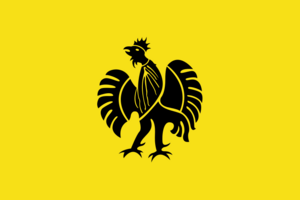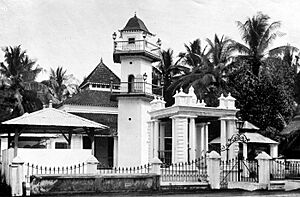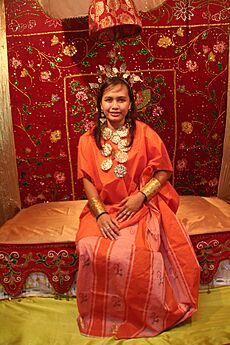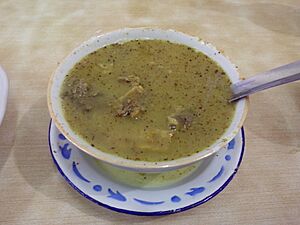Makassar people facts for kids
| ᨈᨕᨘ ᨆᨀᨔᨑ Tu Mangkasaraʼ |
|
|---|---|
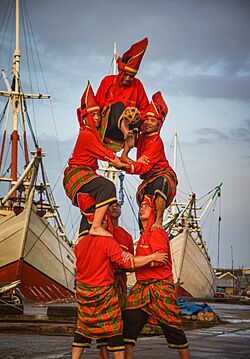
Makassar men performing Tari Praga in their traditional costume
|
|
| Total population | |
| 2,672,590 (2010 census) | |
| Regions with significant populations | |
| 2,672,590 | |
| |
2,380,208 |
| |
59,301 |
| |
41,239 |
| |
31,701 |
| |
29,444 |
| |
25,367 |
| unknown (counted as part of local "Malays") | |
| unknown (counted as part of local "Malays") | |
| Languages | |
| Makassarese, Makassar Malay, Indonesian | |
| Religion | |
| Predominantly Islam | |
| Related ethnic groups | |
| Bugis, Mandar, Toraja | |
The Makassar people are an ethnic group living in the southern part of Sulawesi, an island in Indonesia. They mostly live around Makassar, which is the capital city of South Sulawesi province. You can also find them in the Konjo highlands, along the coast, and on the Selayar and Spermonde islands.
The Makassar people speak two main languages: Makassarese, which is similar to Buginese, and Makassar Malay, a type of Malay language. They are known for their long history of traveling and trading across the seas. Makassar sailors were excellent navigators and traders. They explored many parts of the Indonesian archipelago and even further.
One important journey for the Makassar people was to the northern coast of Australia. They traded with Aboriginal communities, mainly to collect and process sea cucumber. Makassar sailors also built trade networks throughout Southeast Asia, especially in the Malay Peninsula, the Philippines, and Borneo. Their influence can still be seen in the cultures of these areas today.
Contents
History of the Makassar People
The Makassar people originally came from the southern coast of Sulawesi island. Their love for exploration led them to many successful journeys across the oceans. A great example of this was the Kingdom of Gowa, which existed from the 14th to the 17th century. This kingdom became a large Islamic empire with a powerful navy.
The Kingdom of Gowa controlled almost all of Sulawesi island. It also included parts of eastern Kalimantan, East Nusa Tenggara, West Nusa Tenggara, and some of the Maluku. The Makassar people made agreements with other kingdoms, like Bali, Malacca, and Banten. They also had treaties with foreign powers, especially the Portuguese. However, the Kingdom of Gowa was often at war with the Dutch until its fall.
The Makassar people explored vast parts of the world's oceans. They even reached as far as South Africa. In South Africa, there is an area called “Macassar”. It is thought that some local people there might have mixed Makassar and indigenous roots. The name Macassar likely comes from their ancestors' homeland. You can find several places named Macassar in South Africa and nearby Mozambique.
Makassar Contact with Australia
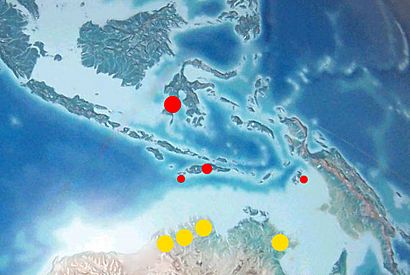
* Makassar (largest red dot) * Rote, Timor, and Aru (other red dots) * Kimberley (three yellow dots) * Arnhem Land (single yellow dot)
Makassar trepangers (sea cucumber collectors) from Sulawesi visited the northern coast of Australia. They came in the 18th and 19th centuries to collect and process trepang, also known as sea cucumber. This marine animal was highly valued in China for its use in cooking and medicine. The term Makassan often refers to all trepangers who came to Australia, even though some were from other Indonesian islands like Timor, Rote, and Aru.
Fishing fleets from Makassar in southern Sulawesi began visiting northern Australia around 1720, or possibly even earlier. Some historians suggest the trade might have started as early as 1640. Ancient rock art found in Arnhem Land in 2008 also suggests Makassar contact in the mid-1600s. Some even think contact could have happened in the 1500s.
At the peak of the trepang trade, Makassans traveled thousands of kilometers along Australia's northern coasts. They arrived each December with the north-west monsoon winds. Their boats, called perahu or praus, could carry about thirty crew members. It's estimated that around one thousand trepangers came each year.
The Makassar crews set up temporary camps on the coast. Here, they would boil and dry the trepang. Four months later, they would sail back home to sell their cargo to Chinese merchants. The Makassans called Arnhem Land Marege, which means "Wild Country." They called the fishing grounds in the Kimberley region of Western Australia Kayu Jawa.
In 1803, Matthew Flinders met a Makassar trepang fleet near modern-day Nhulunbuy. He spoke with a Makassar captain named Pobasso through his cook, who was also Malay. From this talk, Flinders learned how big the trade was. Another explorer, Nicholas Baudin, also saw 26 large perahu off Western Australia that same year.
The last Makassar trepanger to visit Australia was Using Daeng Rangka. He lived well into the 20th century, so his voyages are well-recorded. He first traveled to northern Australia as a young man. He faced challenges like losing his mast and shipwrecks. His relationships with Indigenous Australians were mostly positive, but sometimes difficult.
In 1883, he was the first trepanger to pay a license fee to the South Australian government. This fee made the trade less profitable. The trepang trade slowly ended in the late 19th century due to customs duties, license fees, and possibly too much fishing. Using Daeng Rangka commanded the last Makassar perahu that left Arnhem Land in 1907.
Makassar Lifestyle
The main way Makassar people earn money is through rice farming. However, they are also well-known in Indonesia for their trading skills and as fishermen. This includes catching sea cucumbers, a practice called trepanging in Indonesian.
In traditional Muslim communities, men and women have clear roles. Men usually work outside the home, like farming or fishing. Women are typically in charge of household duties. The man is the head of the family, and his wife and children show him respect in public. The husband usually makes the final decisions for the family. In rural areas, arranged marriages are still common.
The Makassar people accept polygamy, where a man can have more than one wife. However, each wife needs her own house. Because of this, only wealthy people practice polygamy.
Siri is a very important social rule for the Makassar people. It means respect and honor. If someone seriously offends another person's siri, it can lead to serious conflict. The Makassar often help their neighbors with tasks like working in rice fields or building houses.
Makassar Languages
Makassarese Language
The Makassarese language, also called Basa Mangkasara, is spoken by the Makassar people. This language belongs to the Makassaric branch of the South Sulawesi languages group. This group is part of the Malayo-Polynesian branch of the large Austronesian language family.
Makassar Malay Language
This language is commonly known as "Logat Makassar" (Makassar Dialect). It is a creole language based on Malay. This language is used for trade in the port of Makassar, South Sulawesi. In 2000, about 1.889 million people spoke it, and this number is estimated to have grown to around 3.5 million.
Makassar Malay is mostly used by people who have moved to Makassar. It is also spoken by many people in Makassar City, especially young people, or those who are not fluent in Makassarese. This language is spoken throughout the South Peninsula region of Sulawesi.
Religion of the Makassar People
Around the 16th century, South Sulawesi was an important trading hub. Malay Muslim traders and Portuguese traders often visited the area. The local rulers were generally open to both Muslim and Christian religions. They allowed both groups to be present. Around 1537, a Portuguese priest named Padre Manuel d’la Costa visited the Gowa court. Some Gowan noble families decided to become Christian.
According to Antonio de Payva, a Portuguese trader and missionary, the 14th Gowa king, I Mangngarangi Daeng Manrabbia, was hesitant to change his family's traditional faith. He invited Malay priests to compare both religions first. Around 1593, he decided to embrace Islam and took the title of Sultan Aluddin. He then made Islam the official religion of Gowa. Payva noted that Malay traders and priests were generally more accepted than the Portuguese.
Gowa had long-standing relationships with traders from Java, Sumatra, Pattani, Pahang, Champa, and Johor. These relationships began as early as the 9th Gowa king, Tum’parisi Kallona. Under the 11th Gowa king, Tunipalangga, these traders were allowed to practice Islam and had special rights. These communities asked Sultan Muda Alauddin Riayat Shah of Aceh to send Islamic scholars (ulama) to South Sulawesi.
Three Minangkabau ulama named Dato Ri Bandang, Dato Ri Tiro, and Dato Ri Patimang were sent to spread Islam in South Sulawesi. They learned about Bugis-Makassar culture from sailors in Riau and Johor. With help from the Sultan of Johor, they learned from the Wali Songo of Java before arriving in Somba Opu harbor in the early 17th century.
Islam had some similarities with the native practice of Dewata Sewwae in the Luwu Kingdom. Luwu was seen as a spiritual center in South Sulawesi. So, when the rulers of Luwu converted first, they encouraged conversion in Gowa-Tallo. Gowa-Tallo had the power to spread Islam in South Sulawesi, which Luwu lacked. Conversion started slowly and peacefully, adapting to local traditions.
By 1611, most of the Makassar and Bugis kingdoms had converted to Islam. Today, almost all Makassar people are Muslim. However, some traditional beliefs from before Islam are still important, especially in remote areas.
Makassar Culture
Philosophy of Siri' Na Pacce
Siri' Na Pacce is a key cultural idea for the Bugis-Makassar people. It represents a strong sense of respect, honor, and self-esteem, combined with a spirit of togetherness and resilience.
Traditional Attire: Baju Bodo
The Baju bodo (meaning 'short blouse' in Makassarese) is a traditional top worn by Makassar women. It is a rectangular, short-sleeved blouse, usually ending above the elbow.
In Makassar culture, the color of the baju bodo shows the age or importance of the person wearing it. It is often worn for special events like wedding ceremonies. Today, the baju bodo is also seen in other events, such as dance competitions or welcoming ceremonies for guests.
Makassar Cuisine
Makassar food uses a mix of ingredients from farms and the sea. In cities on the west coast, like Makassar, Maros, and Pangkep, there are coastal areas right next to rice fields. The farming areas in Maros and Pangkep are quite large. Rice and other crops like bananas are plentiful. Most traditional cakes (kue) and desserts are made mainly from rice and bananas.
The coastal areas of South Sulawesi produce a lot of fish. Ponds on the west coast are full of bolu (milkfish), sunu (grouper), shrimps, and crabs. Fishing in coastal and deep-sea areas is also very developed. Among the fish caught, tunas are the most common.
Dishes made from beef or buffalo show the "farming pattern" in Makassarese cooking. Good examples include coto, konro, sop saudara, and pallubasa. People living in coastal cities with many sea resources mainly eat fish.
Differences Between Buginese and Makassar People
Some people mistakenly think that the Makassar and Buginese people are the same ethnic group. They might believe that the terms Buginese and Makassar were created by the Dutch colonizers to divide them. However, this is not true.
In terms of language, Makassarese and Buginese are different languages. Both belong to the South Sulawesi languages group, which is part of the Malayo-Polynesian languages branch of the Austronesian languages. But within this group, Makassarese is in the same sub-category as Bentong, Coastal and Highland Konjo, and Selayar. Buginese is in a different sub-category, along with Campalagian language and two languages spoken in Kalimantan, Embaloh and Taman. These language differences show that the Bugis and Makassar people are distinct groups.
The idea that the Buginese and Makassar people are ethnically the same comes from the time when kingdoms like Bone state and Wajo Kingdom were conquered by the Sultanate of Gowa.
See also
- Bugis people
- Ethnic groups in Indonesia
- Overseas Indonesians
- Indonesians


